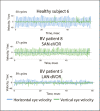Optimized Signal Analysis to Quantify the Non-Linear Behaviour of the Electrically Evoked Vestibulo-Ocular Reflex in Patients with a Vestibular Implant
- PMID: 35817001
- PMCID: PMC9808707
- DOI: 10.1159/000525577
Optimized Signal Analysis to Quantify the Non-Linear Behaviour of the Electrically Evoked Vestibulo-Ocular Reflex in Patients with a Vestibular Implant
Abstract
Introduction: Different eye movement analysis algorithms are used in vestibular implant research to quantify the electrically evoked vestibulo-ocular reflex (eVOR). Often, standard techniques are used as applied for quantification of the natural VOR in healthy subjects and patients with vestibular loss. However, in previous research, it was observed that the morphology of the VOR and eVOR may differ substantially. In this study, it was investigated if the analysis techniques for eVOR need to be adapted to optimize a truthful quantification of the eVOR (VOR gain, orientation of the VOR axis, asymmetry, and phase shift).
Methods: "Natural" VOR responses were obtained in six age-matched healthy subjects, and eVOR responses were obtained in eight bilateral-vestibulopathy patients fitted with a vestibular implant. Three conditions were tested: "nVOR" 1-Hz sinusoidal whole-body rotations of healthy subjects in a rotatory chair, "eVOR" 1-Hz sinusoidal electrical vestibular implant stimulation without whole-body rotations in bilateral-vestibulopathy patients, and "dVOR" 1-Hz sinusoidal whole-body rotations in bilateral-vestibulopathy patients using the chair-mounted gyroscope output to drive the electrical vestibular implant stimulation (therefore also in sync 1 Hz sinusoidal). VOR outcomes were determined from the obtained VOR responses, using three different eye movement analysis paradigms: (1) peak eye velocity detection using the raw eye traces; (2) peak eye velocity detection using full-cycle sine fitting of eye traces; (3) peak eye velocity detection using half-cycle sine fitting of eye traces.
Results: The type of eye movement analysis algorithm significantly influenced VOR outcomes, especially regarding the VOR gain and asymmetry of the eVOR in bilateral-vestibulopathy patients fitted with a vestibular implant. Full-cycle fitting lowered VOR gain in the eVOR condition (mean difference: 0.14 ± 0.06 95% CI, p = 0.018). Half-cycle fitting lowered VOR gain in the dVOR condition (mean difference: 0.08 ± 0.04 95% CI, p = 0.009). In the eVOR condition, half-cycle fitting was able to demonstrate the asymmetry between the excitatory and inhibitory phases of stimulation in comparison with the full-cycle fitting (mean difference: 0.19 ± 0.12 95% CI, p = 0.024). The VOR axis and phase shift did not differ significantly between eye movement analysis algorithms. In healthy subjects, no clinically significant effect of eye movement analysis algorithms on VOR outcomes was observed.
Conclusion: For the analysis of the eVOR, the excitatory and inhibitory phases of stimulation should be analysed separately due to the inherent asymmetry of the eVOR. A half-cycle fitting method can be used as a more accurate alternative for the analysis of the full-cycle traces.
Keywords: Bilateral vestibular areflexia; Bilateral vestibulopathy; Eye movement analysis algorithm; Neural prosthesis; Signal fitting; Vestibular implant; Vestibular prosthesis; Vestibulo-ocular reflex.
© 2022 The Author(s). Published by S. Karger AG, Basel.
Conflict of interest statement
MEDEL provided the VCI devices and funding for travel for Angélica Pérez Fornos, Nils Guinand, and Raymond van de Berg. MEDEL, ZonMw, Heinsius Houbolt Foundation, and the Weijerhorst foundation provided grants for vestibular implant research for Raymond van de Berg. Tomsk State University Development Programme (“Priority-2030”) provided a grant for vestibular implant research for Dmitrii Starkov and Maksim Pleshkov.
Figures





